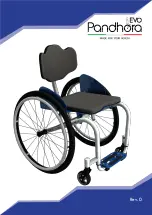
SECTION 2—SAFETY/HANDLING OF WHEELCHAIRS
Part No. 1110546
9
Tracer® EX2
SECTION 2—SAFETY/HANDLING OF WHEELCHAIRS
Safety/Handling of Wheelchairs
Safety
and
handling
of
the
wheelchair
require
the
close
attention
of
the
wheelchair
user
as
well
as
the
assistant.
This
manual
points
out
the
most
common
procedures
and
techniques
involved
in
the
safe
operation
and
maintenance
of
the
wheelchair.
It
is
important
to
practice
and
master
these
safe
techniques
until
you
are
comfortable
in
maneuvering
around
the
frequently
encountered
architectural
barriers.
Use
this
information
only
as
a
basic
guide.
The
techniques
that
are
discussed
on
the
following
pages
have
been
used
successfully
by
many.
Individual
wheelchair
users
often
develop
skills
to
deal
with
daily
living
activities
that
may
differ
from
those
described
in
this
manual.
Invacare
recognizes
and
encourages
each
individual
to
try
what
works
best
for
him/her
in
overcoming
architectural
obstacles
that
they
may
encounter.
However,
all
warnings
and
cautions
given
in
this
manual
MUST
be
heeded.
Techniques
in
this
manual
are
a
starting
point
for
the
new
wheelchair
user
and
assistant
with
“safety”
as
the
most
important
consideration
for
all.
Stability and Balance
WARNING
ALWAYS wear your seat positioning strap. Inasmuch as the seat positioning strap is an option on
this wheelchair (you may order with or without the seat positioning strap), Invacare strongly rec-
ommends ordering the seat positioning strap as an additional safeguard for the wheelchair user.
The seat positioning strap is a positioning belt only. It is not designed for use as a safety device
withstanding high stress loads such as auto or aircraft safety belts. If signs of wear appear, belt
MUST be replaced IMMEDIATELY.
To
assure
stability
and
proper
operation
of
your
wheelchair,
you
MUST
maintain
proper
balance
at
all
times.
Your
wheelchair
has
been
designed
to
remain
upright
and
stable
during
normal
daily
activities
as
long
as
you
do
not
move
beyond
the
center
of
gravity.
Virtually
all
activities
which
involve
movement
in
the
wheelchair
have
an
effect
on
the
center
of
gravity.
Invacare
recommends
using
seat/chest
positioning
straps
for
additional
safety
while
involved
in
activities
that
shift
your
weight.
DO
NOT
lean
forward
out
of
the
wheelchair
any
further
than
the
length
of
the
armrests.
Make
sure
the
casters
are
pointing
in
the
forward
position
whenever
you
lean
forward.
This
can
be
achieved
by
advancing
the
wheelchair
and
then
reversing
it
in
a
straight
line.
Coping With Everyday Obstacles
Coping
with
the
irritation
of
everyday
obstacles
can
be
alleviated
somewhat
by
learning
how
to
manage
your
wheelchair.
Keep
in
mind
your
center
of
gravity
to
maintain
stability
and
balance.
A Note to Wheelchair Assistants
When
assistance
to
the
wheelchair
user
is
required,
remember
to
use
good
body
mechanics.
Keep
your
back
straight
and
bend
your
knees
whenever
tipping
the
wheelchair
or
traversing
curbs,
or
other
impediments.
DO
NOT
attempt
to
lift
the
wheelchair
by
any
removable
(detachable)
parts.
Lifting
by
means
of
any
removable
(detachable)
parts
of
the
wheelchair
may
result
in
injury
to
the
user
or
damage
to
the
wheelchair.
If
the
wheelchair
is
exposed
to
extreme
temperature
(above
100°F
or
below
32°F),
high
humidity
and/or
becomes
wet,
prior
to
use,
ensure
handgrips
do
not
twist
on
the
wheelchair’s
handle
‐
otherwise
damage
or
injury
may
occur.
Also,
be
aware
of
detachable
parts
such
as
armrests
or
legrests.
These
MUST
NEVER
be
used
to
move
the
wheelchair
or
as
lifting
supports,
as
they
may
be
inadvertently
released,
resulting
in
possible
injury
to
the
user
and/or
assistant(s).
When
learning
a
new
assistance
technique,
have
an
experienced
assistant
help
you
before
attempting
it
alone.










































